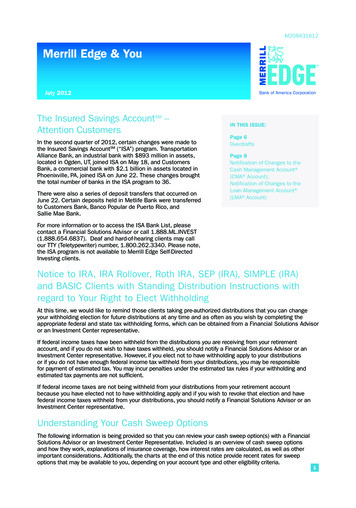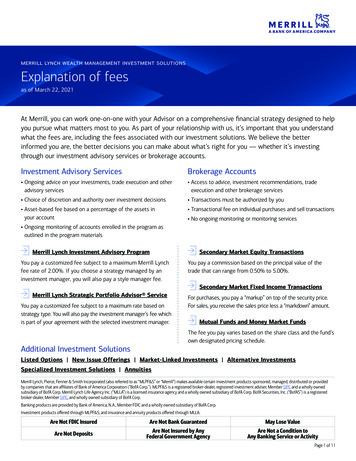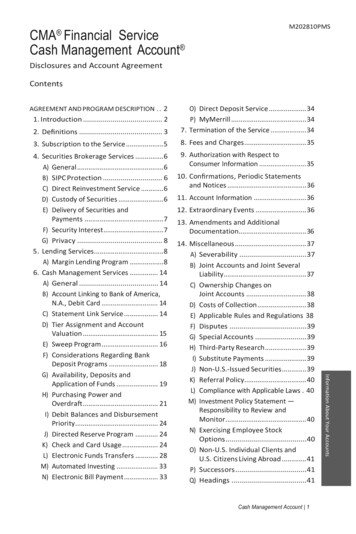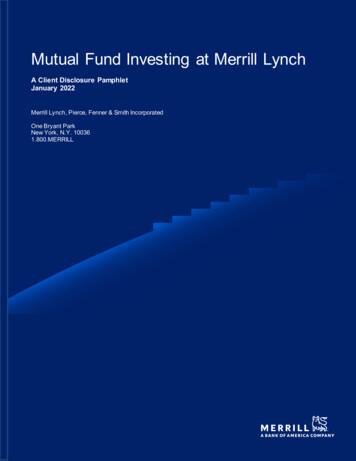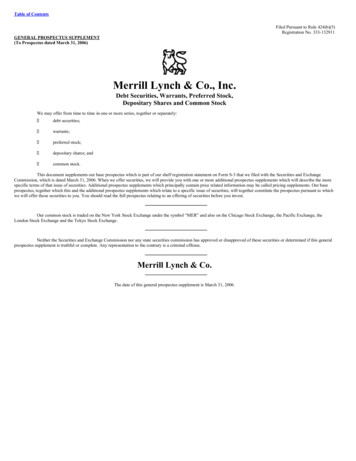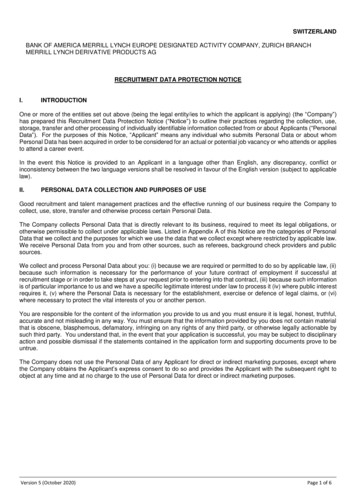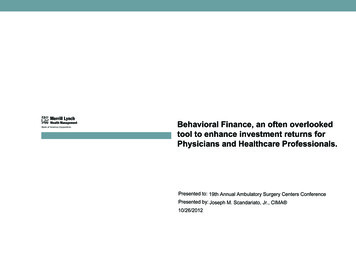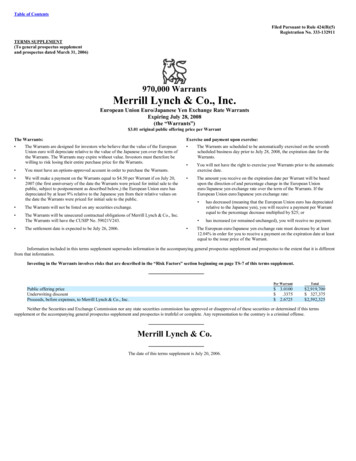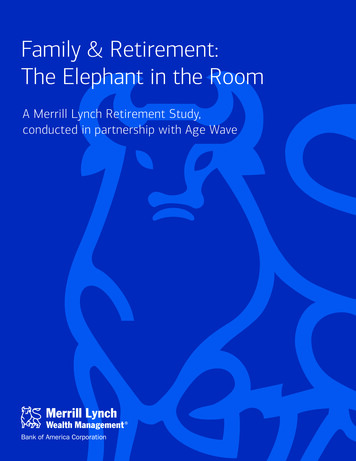
Transcription
Family & Retirement:The Elephant in the RoomA Merrill Lynch Retirement Study,conducted in partnership with Age Wave
Merrill Lynch Wealth Management makes available products and services offered by Merrill Lynch, Pierce, Fenner & Smith Incorporated (“MLPF&S”), a registeredbroker-dealer and member SIPC, and other subsidiaries of Bank of America Corporation (“BAC”).Investment products offered through MLPF&S and insurance and annuity products offered through Merrill Lynch Life Agency Inc.:Are Not FDIC InsuredAre Not Bank GuaranteedMay Lose ValueAre Not DepositsAre Not Insured by Any Federal GovernmentAgencyAre Not a Condition to Any Banking Serviceor ActivityMerrill Lynch Life Agency Inc. is a licensed insurance agency and a wholly owned subsidiary of BAC. 2013 Bank of America Corporation. All rights reserved. ARN9NHGD 102497-1113FAMILY & RETIREMENT: THE ELEPHANT IN THE ROOM2
Table of ContentsIntroduction. . . . . . . . . . . . . . . . . . . . . . . . . . . . . . . . . . . . . . . . . . . . . . . . . . . . . . . . . . . . . . . . . . . . . . . . . . . . . . . . . . . . . . . . . . Page 4Methodology . . . . . . . . . . . . . . . . . . . . . . . . . . . . . . . . . . . . . . . . . . . . . . . . . . . . . . . . . . . . . . . . . . . . . . . . . . . . . . . . . . . . . . . . . Page 5Are You the Family Bank? Can You Afford to Be?. . . . . . . . . . . . . . . . . . . . . . . . . . . . . . . . . . . . . . . . . . . . . . . . . . . . . . . . . . . Page 6Retirement’s Unexpected Worry: Being a Burden. . . . . . . . . . . . . . . . . . . . . . . . . . . . . . . . . . . . . . . . . . . . . . . . . . . . . . . . . . . Page 12Silence Is Not Golden: Proactive Communication Key to Preventing Catastrophes. . . . . . . . . . . . . . . . . . . . . . . . . . . . . . . Page 15Conclusion . . . . . . . . . . . . . . . . . . . . . . . . . . . . . . . . . . . . . . . . . . . . . . . . . . . . . . . . . . . . . . . . . . . . . . . . . . . . . . . . . . . . . . . . . . . Page 18Endnotes . . . . . . . . . . . . . . . . . . . . . . . . . . . . . . . . . . . . . . . . . . . . . . . . . . . . . . . . . . . . . . . . . . . . . . . . . . . . . . . . . . . . . . . . . . . . Page 19FAMILY & RETIREMENT: THE ELEPHANT IN THE ROOM3
IntroductionFor most, family makes life—and life in retirement—richerand more enjoyable. But family connections can alsocomplicate retirement. Retirement planning has traditionallycentered largely on the needs of an individual or a couple.This landmark Study reveals the impact that today’s familycomplexities and financial interdependencies have onretirement, and shows how pre-retirees and retirees canbetter plan, engage and communicate with family membersto balance both family priorities and their own long-termretirement security.Family & Retirement: The Elephant in the Room reveals pitfallsand safer passages as pre-retirees and retirees navigatetoday’s modern family dynamics, including:The lives of retirees and pre-retirees today are complicatedby three converging trends: Parenthood Doesn’t Retire. In today’s uncertaineconomy, adult children and other younger relatives—struggling with career stalls and financial difficulties—areincreasingly turning to older family members for a helpinghand.Extended Lives, Extended Needs. At the same time,rising longevity is introducing new complications. Theparents of today’s pre-retirees and retirees are livinglonger than any prior generation and very often requiregreater emotional, physical and financial support. Finding oneself in the role of the “Family Bank” The impact providing family support can have onretirement Why ground rules and boundaries are important whenproviding support for family members The financial challenges of blended families and divorce What it means to be a burden on one’s family What steps people are taking—or not taking—to avoidbecoming a burden on family The impact family challenges and crises can have onretirement preparedness How discussing, planning and coordinating with familymembers around important financial topics can increaseeveryone’s peace of mindThe following report summarizes the key findings of our Study.Stretched and Stressed. Many pre-retirees andretirees have insufficient savings, putting them onshaky ground as they attempt to balance the competingpriorities and tradeoffs of preparing for and financiallymanaging their own retirement while also helping familymembers.FAMILY & RETIREMENT: THE ELEPHANT IN THE ROOM4
MethodologyThe survey included a total of 5,415 respondents age 25 , including 2,104 respondents among the Boomer (age47-67) and Silent (age 68-88) generations, 250 Millennials (age 25-36), and 252 respondents among GenerationX (age 37-48). In addition, select findings are based on an oversample of 2,809 affluent respondents age 50 with at least 250,000 in investable assets (including liquid cash and investments, but excluding real estate).Among the affluent respondents, 2,506 had assets from 250,000 to 5 million and 303 had assets of 5 millionor more. The survey, which was completed in August 2013, was conducted in partnership with Age Wave andexecuted online by Harris Interactive. Focus groups were also conducted among both pre-retirees and retirees.Merrill Lynch Global Wealth ManagementMerrill Lynch Global Wealth Management is a leading provider of comprehensive wealth management and investment servicesfor individuals and businesses globally. With over 14,000 Financial Advisors and 1.8 trillion in client balances as of September30, 2013*, it is among the largest businesses of its kind in the world. Within Merrill Lynch Global Wealth Management, thePrivate Banking and Investment Group provides tailored solutions to ultra affluent clients, offering both the intimacy of aboutique and the resources of a premier global financial services company. These clients are served by more than 150 PrivateWealth Advisor teams, along with experts in areas such as investment management, concentrated stock management andintergenerational wealth transfer strategies. Merrill Lynch Global Wealth Management is part of Bank of America Corporation.Age WaveAge Wave is the nation’s foremost thought leader on population aging and its profound business, social, financial, healthcare,workforce, and cultural implications. Under the leadership of Founder/CEO Dr. Ken Dychtwald, Age Wave has developed aunique understanding of new generations of maturing consumers and workers and their expectations, attitudes, hopes and fearsregarding retirement. Since its inception in 1986, the firm has provided breakthrough research, compelling presentations, awardwinning communications, education and training systems, and results-driven marketing and consulting initiatives to over half theFortune 500. For more information, please visit www.agewave.com. Age Wave is not affiliated with Bank of America Corporation.* Source: Bank of America. Merrill Lynch Global Wealth Management (MLGWM) represents multiple business areas within Bank of America’s wealth and investment management divisionincluding Merrill Lynch Wealth Management (North America and International), Merrill Lynch Trust Company, and Private Banking & Investments Group. As of September 30, 2013, MLGWMentities had approximately 1.8 trillion in client balances. Client Balances consists of the following assets of clients held in their MLGWM accounts: assets under management (AUM) ofMLGWM entities, client brokerage assets, assets in custody of MLGWM entities, loan balances and deposits of MLGWM clients held at Bank of America, N.A. and affiliated banks.FAMILY & RETIREMENT: THE ELEPHANT IN THE ROOM5
Are You the Family Bank?Can You Afford to Be?Six in ten people age 50 today are providing financial support to family members in need. This support is oftenleniently and generously given. Half of pre-retirees age 50 say they would make major sacrifices to help familymembers.A New Era of Family InterdependenciesSix in ten people (62%) age 50 today are providing financialsupport to family members. This support may be to meeta one-time need, or it could be ongoing assistance over thecourse of many years, and is often offered without expectinganything in return. But those providing support to familymembers are often not accounting for it in their retirementplanning, nor are they talking with family members about it,which can pose a hidden risk to retirement.Financial help extends in multiple directions, including adultchildren, grandchildren, parents and in-laws and siblings(FIG 1). The amount of support provided by people age 50 to family can be thousands of dollars a year, and averages 14,900 among people with less than 5 million in investableassets (FIG 2).68%26%16%Adult children(age 21 )GrandchildrenParents/in-laws13%14%SiblingsOther relativesBase: age 50 , with adult her relatives; bases varyFigure 2: Financial support provided to family members in 34,100Are You the “Family Bank?” 19,100Three out of five people (56%) age 50 believe a member oftheir family is the “Family Bank,” meaning someone who theirextended family is most likely to turn to for financial help.“I thought I would be supplementing my grandchildren’s collegefunds. It turns out I was the college fund.”– Focus Group ParticipantThe role of the Family Bank is often assigned to those whosaved and invested responsibly. In fact, the more financiallyresponsible you are, the more likely other family memberswill consider you to be the Family Bank (FIG 3). 14,900 9,200AverageFAMILY & RETIREMENT: THE ELEPHANT IN THE ROOM 500k- 5mFigure 3: Reasons why a family member is turned to for44%responsible41%Has the most money37%Easiest to approach15%Lives nearby“I paid down my mortgage and didn’t run up my credit cards,unlike my sisters. Now everyone in my family is turning to mefor money.”– Focus Group Participant 250k- 500k 250k11%The eldestDoes nothave children7%Base: age 25 6
Generational GenerosityHalf of pre-retirees age 50 say they would make majorsacrifices that could impact their retirement to help familymembers. Among these pre-retirees, three in five say theywould retire later, four in ten would return to work afterretirement, and more than one-third say they would accept aless comfortable retirement lifestyle to help family financially(FIG 4).Those helping family members rarely do so because theyexpect future help or financial payback. Older adults are 20xmore likely to say they are helping family because “it is theright thing to do” than because “family members will help mein the future” (FIG 6). They are 5x more likely to stop familysupport because the recipient is not using the money wiselythan because of worries about being paid back (FIG 7).Figure 4:Figure 6:to family membersmembersIt was the rightthing to doAmong age 50 pre-retirees willing to alter their retirement60%Retire later/work longerI felt it was myfamily obligationHave a less comfortablelifestyle in retirement50%They helped mein the past40%retirement80%To be more involvedin their lives36%So they will help mein the futureif I need it20%15%7%4%Base: age 50 pre-retirees willing to alter retirement plans to support family. 50% of these pre-retirees wouldFamily Bank: Open 24/7, Lenient TermsIn addition to being willing to make major sacrifices to theirown retirement and financial security in order to supportfamily members, many pre-retirees and retirees also cite thatthey give support without even knowing how the money isbeing used (FIG 5).36%20%18%17%Rent/mortgage/home purchaseCell phone billPurchase or lease a carEducation expensesHealthcare expensesPay down debtInsuranceStudent loansCredit card billsLegal matters15%15%13%11%11%10%9%Feeling they were notusing money wisely57%Started hurting myown lifestyle36%I felt they did notappreciate my helpFigure 5: Reasons people age 50 give adult childrenmoneyDon’t know, just gave moneyFigure 7:membersWorry they won’t beable to pay me back34%11%Base: age 50 “I’m not looking to get back the money I loaned my daughter.I’m just happy I could help her when she needed it.”– Focus Group ParticipantBase: age 50 , with adult childrenFAMILY & RETIREMENT: THE ELEPHANT IN THE ROOM7
Those giving money to family members are 3x more likely tofeel “appreciated” than “taken advantage of” (FIG 8).This generational generosity also extends to a shift inmindset regarding inheritance and giving to family. Three infive (60%) people age 50 say it is better to pass on theirassets now rather than waiting until end of life. Age 50 women are even more likely than men to say it is better topass on inheritance during retirement (65% vs. 53%).Figure 8: How people age 50 feel about helping family54%Appreciated36%Generous24%Proud18%Taken advantage of“Why should I wait until I die to leave my inheritance? Mychildren can use my help now, and I want to be there to enjoyhelping them.”Like I will su erfor it7%– Focus Group ParticipantFamily Support: Unforeseen, UnpreparedUnfortunately, very few people have prepared financially forpotential family events and challenges. The vast majorityof people age 50 have never budgeted and prepared forproviding financial support to other family members (88%),caring for an aging parent or relative (91%), or helping topay for their grandchildren’s education (91%)—even thoughthey are highly likely to provide such support. This lack ofpreparation extends to end-of-life issues as well. Amongpeople age 50 , half (51%) have a will, four in ten have ahealthcare directive (42%) and just one-third of people age50 have both a will and a healthcare directive.FAMILY & RETIREMENT: THE ELEPHANT IN THE ROOM8
Blended Families Alter the Face of RetirementSpecial Strains of StepfamiliesRising divorce rates, which peaked in the 1980s, have createdmore complex families among today’s pre-retirees and retirees(FIG 9). Roughly three-quarters of people who divorce remarry,1often introducing stepchildren, stepparents and stepsiblings intothe family and financial mix. Nearly two in five people age 50 are now part of a blended family (FIG 10).Members of stepfamilies have unique challenges whenmeeting family financial needs. Adults age 50 generally feelsome financial responsibility for stepfamily members (mostparticularly stepchildren), but usually less responsibility thanthey feel for biological relatives (FIG 11).Figure 9: Number of divorces per year among 1,000married women age 15 Figure 11:responsible for 2321192183%Parent31%1581%9Adult child1960197019801990200062%51%2010SiblingSource: U.S. Census Bureau; CDC18%Figure 10: Percent of people age 50 who have.Biological relativeStep-relativeBase: age 50 , with parent/stepparent, etc.; top two box; bases vary37%20%20%7%Any steprelativesStepsiblingStepchildStepparent“I am very happy we are able to help our stepson. He is havinga difficult time. But to be honest, I want to help my owndaughter more, and it is a hard thing to talk about with myhusband.”– Focus Group ParticipantSource: Pew Social and Demographic Trend Survey, October 2010; Age Wave calculationsFAMILY & RETIREMENT: THE ELEPHANT IN THE ROOM9
Nearly one-third (31%) of people age 50 who havestepchildren say it complicates financial planning. Three inten (32%) also say that they and their spouses have differentfinancial priorities for their own children than they have for theirstepchildren. Those with stepchildren are less likely to dividetheir assets equally than those without stepchildren (FIG 12).Figure 12: Percent who will not divide assets equallyamong children22%14%No stepchildrenHave stepchildrenBase: age 50 , with more than one childFathers are more likely than mothers to say that their financialplans treat their stepchildren exactly the same (90% vs. 61%)and that they feel financially responsible for their stepchildren(72% vs. 51%).Gray DivorceDivorce is becoming increasingly common among older adults,which can have a significant impact on retirement savings andplans. Overall, the percent of people who divorced per year inthe U.S. among all ages was essentially unchanged between1990 and 2010. However, during this time period, the divorcerate among those age 50 doubled. 2Figure 13: Percent age 50 who are divorced and single700% increaseOne in seven people age 50 who were once married are nowdivorced and single, a sevenfold increase from 1960 (FIG 13).Divorce in maturity often creates substantial financial hardships,especially for women. After a divorce, household income dropsby more than 40% for women and by about 25% for men.314%12%8%6%4%2%196019701980199020002010Source: U.S. Census Bureau, 2013; Age Wave calculationsFAMILY & RETIREMENT: THE ELEPHANT IN THE ROOM10
Marriage Gets Better in RetirementConnecting with GrandchildrenDivorce may be becoming more common in later life, butoverwhelmingly retirees are more likely to say their maritalsatisfaction has improved, not diminished, since retiring.Close to half say their marriage is more fulfilling and lovingin retirement, while only one in ten say it is more boring orcontentious (FIG 14).More than half (54%) of people age 50 are grandparents,having an average of nearly five grandchildren each. In manyways, technology is helping to revolutionize how grandparentsconnect with their grandchildren. Nearly three in fivegrandparents (57%) say technology today makes it much easierto stay connected with family members. While technologyhelps keep families connected, grandparents say having funtogether and teaching and passing on family values—muchmore so than staying hip with trends—are the best ways to bea good grandparent (FIG 15).Figure 14: Percent of retirees who say their marriage hasbecome more 48%Ful lling45%Loving33%FunBoring11%Contentious11%Base: age 50 , retirees, marriedFigure 15: What does it mean to be a good grandparent?44%Having fun together39%Teaching and passing onfamily valuesNot interfering withparentsMaintaining one’s health36%21%17%Not overindulginggrandchildren15%Planning regular visitsRespecting grandkids’boundaries12%7%Embracing new technologyStaying current withtoday’s trends2%Base: grandparents age 50 “In retirement there is more quality time. My husband and I doeverything together.”– Focus Group Participant“I want to be a very active grandmother. I want to go on familytrips with my son, go to my grandchildren’s baseball games,take them to ballet dance. I want to be a vital part of theirlives.”– Focus Group ParticipantFAMILY & RETIREMENT: THE ELEPHANT IN THE ROOM11
Retirement’s Unexpected WorryBeing a BurdenAs people age, “being a burden on family” and “running out of money” become the top concerns. Older adults are mostlikely to define “being a burden” as having family members providing hands-on care. While the #1 choice for long-termcare, if needed, is in their own home, two-thirds of people age 50 admit that they have taken no steps to maintaintheir independence.Retirement’s Two Greatest WorriesWhat It Means to Be a Burden on FamilyThere are two top worries in retirement, which change inpriority as people age. Younger generations say their greatestworry about living a long life is running out of money to livecomfortably. But in later life, another worry weighs just asheavily: Older adults say “being a burden on family” is ofequal concern (FIG 16). Women age 50 are even more likelythan men to say “being a burden on family” is their greatestworry (32% vs. 18%).Older adults are most likely to define “being a burden” ashaving family members “physically take care of” them (FIG17). The need for eldercare can have repercussions acrossgenerations. While family members may need to pay for orcoordinate care, asking family members to provide hands-oncare is the top anxiety.Figure 16: Greatest worry about living a long life51%Having family members physicallytake care of meGen XSilent Generation38%Running out ofmoney to livecomfortably31%26%21%16%Ending up in anursing home24%13%10%7%Having to movein with them25%22%Being a burdenon my family“I have always been independent. I am the one who is there tohelp my family. The last thing I want is to have to turn to themfor help.”FAMILY & RETIREMENT: THE ELEPHANT IN THE ROOMCausing emotional stress andworry among family members28%Base: age 50 Base: Generation X (age 37-48), Boomers (age 49-67), Silent Generation (age 68-88)– Focus Group Participant30%Having to ask them for money orto help pay my bills11%Being lonely49%Taking my family away from theirown lives to care for meBoomers31%Figure 17:Parents Moving in with You? Fathers More Likely toFeel They Will Be a BurdenAmong those age 50 , men are likely to have greater anxietyabout how their adult children would feel about them movingin later in life. Fathers are more likely than mothers tobelieve their children will feel burdened by such responsibility(48% vs. 36%). And more mothers than fathers believe theirchildren would say they are fulfilling their obligation (43% vs.31%).12
Alzheimer’s: The Cost of LongevityWorries about Alzheimer’s disease escalate as people age.While younger people consider cancer to be the greatesthealth-related worry of later life, older adults unequivocallysay it’s Alzheimer’s—which can require years of caregivingand cause tremendous distress and rapid depletion offinancial resources among close family members (FIG 18).Figure 18: Greatest health worries in later life37%31%39%Millennials37%Gen X33%BoomersSilent Generation28%23%17%18%14%17% 17%12%16%14%8%Alzheimer’sCancerHeart attack9%10%Stroke8%10%DiabetesBase: Millennials (age 25-36), Generation X (age 37-48), Boomers (age 49-67), Silent Generation (age 68-88)Alzheimer’s is far too common in later life. Nearly half ofpeople age 85 have Alzheimer’s or related dementias(FIG 19).4Figure 19: Prevalence of Alzheimer’s disease by age45%Currently, there are over 5 million people with Alzheimer’s.5But as we continue to live longer, and as the age 85 population increases, more and more people will suffer fromthis disease unless a cure or treatment is found.18%1%Under 652%65-7475-8485 Source: U.S. Department of Health and Human Services, Administration on Aging; Hebert et al. 2003FAMILY & RETIREMENT: THE ELEPHANT IN THE ROOM13
Home: The #1 Choice for Long-Term CareThe vast majority of older adults say they would prefer toreceive care in their own home, if needed. Just 2% say theirfirst choice would be to receive care in a family member’shome—a choice as unpopular as moving to a nursing home(FIG 20).Although nearly all older adults say they would prefer not tohave to move in with family, two-thirds of people age 50 admit that they have taken no steps to avoid having to livewith a family member if unable to live on their own (FIG 21).Figure 20: Top choice to receive long-term care, if neededFigure 21: Steps taken so that it won’t be necessary tomove in with family, if unable to live on own86%In my own homeIn an assistedliving facility10%In a familymember’s home2%In a nursinghome2%Base: age 50 I have done nothing66%Ensured adequatesavings to pay forcare if I need it19%Bought long-term careinsurance11%My plan is to live withmy children or familymember5%Other4%Base: age 50 In part, inaction may be driven by lack of awareness—orworse, denial. While 37% of people age 50 believe theymay need long-term care in their lifetime, the reality is that70% will eventually need long-term care (FIG 22).Figure 22: Percent who believe they will need long-termcare versus percent who will need long-term careBelievethey will needlong-term care37%Will needlong-term care*70%Base: age 50 Source: U.S. Department of Health and Human Services, 2013FAMILY & RETIREMENT: THE ELEPHANT IN THE ROOM14
Silence Is Not GoldenProactive Communication Key to Preventing CatastrophesMost people are reactive, not proactive, when discussing and coordinating important financial decisions withfamily members. Few have had any discussions regarding important financial topics with their spouse, adultchildren or parents. Active discussions and coordination with family members can be the difference betweensmooth sailing and significant hardship when confronting family challenges throughout retirement.The Family FactorFamily challenges and crises can derail years of responsibleretirement preparation. While already a mere one-thirdof people age 50 say that they feel well prepared forretirement if everything goes as they expect, less than aquarter would feel prepared if they or their spouse needed toretire early for health reasons or if a spouse died. Only aboutone in ten would feel well prepared if they had to provideextended care or support to a family member (FIG 23).Figure 23: Percent saying they are prepared for retirementIf everything goesas I expect Half (51%) of women over age 70 have been widowed.6 One-third (34%) of people who retire early do so forhealth reasons.7 One in five people (19%) age 50 have “boomerang” adultchildren who have moved back in with them, according tothis study. There are 66 million people in the U.S. providing extendedcare to loved ones.833%If my spouse dies24%If either my spouse or I amforced to retire early becauseof a health problem23%If an adult child moves backin and needs supportIf a loved one needsextended long-term careUnfortunately, family-related events can create financialhardship in retirement. For example:15%9%Base: age 50 ; top two box out of ten; bases vary“I have a Christmas account. I have a vacation account. I’venever had an account thinking I’m going to have to take care ofmy parents. Maybe I should.”– Focus Group ParticipantFAMILY & RETIREMENT: THE ELEPHANT IN THE ROOM15
Troubling Lack of DiscussionThere is a dangerous absence of planning, discussion,coordination and establishment of safe boundaries as peoplenavigate these new family interdependencies. This lack ofproactive engagement and discussion can negatively impactevery aspect of a person’s retirement.Very few people talk with close family members aboutimportant financial topics, such as level of financial security,plans for living arrangements in retirement, inheritance orlong-term care. Seventy percent of those age 25 have nothad an in-depth discussion with their parents about theseretirement issues. More than half of those age 50 have nothad such discussions with their adult children, and nearly onethird age 50 have not even had such discussions with theirspouse (FIG 24). Just one in four (24%) have discussed howtheir parents will be financially provided for or cared for asthey get older.Worry about causing family conflicts is the top reason for notdiscussing important financial issues with family members(FIG 25). In fact, these discussions often don’t start untilconfronting a crisis, such as a death or an illness (FIG 26).Unfortunately, lack of proactive discussion today can causeeven more difficulty and conflict when a family crisis arises.It can also lead to people becoming a burden on their family—the very thing they most want to avoid.Figure 25: Top barriers to having proactive discussions on24%Too uncomfortableto discuss19%17%Don’t think it will helpFigure 24: Percent who have ever had in-depth discussionson the following topics with Family members don’twant me to know howmuch money they have13%Don’t want family to knowhow much money I have11%Don’t know how to startthe conversation10%Net worthHow to pay for long-term careWhere to liveWill or inheritance plansBase: age 50 None of these70%56%42%36%22%11%8% 10%Figure 26:57%41%27%28%Parents43%We’ve always talked15%13%10%Adult childrenDeath/illness of familymember/friendI experienced ahealth problemSpouseBase: vary by column groups: age 25 , age 50 with adult children, age 50 and married21%20%problemsFinancial problems of afamily member or friend“I just never wanted to talk about it with my sister. It was theelephant in the room. We both knew Mom’s health was failing,but it was like we pretended it wasn’t happening. Then whenshe got sick, we wished we had talked about it sooner. It was anightmare.”29%Change in family, e.g.,marriage, divorce, etc.17%12%Base: age 50 – Focus Group ParticipantFAMILY & RETIREMENT: THE ELEPHANT IN THE ROOM16
The Payoff of Proactive Planning and DiscussionThere is a need—and payoff—for thoughtfulness anddiscussion about retirement as pre-retirees and retirees planfor how they’re going to support their family as they moveto—and through—retirement. Those who have had financialdiscussions with their spouses or adult children are almosttwice as likely to say they would be well prepared if theywere to face family challenges (FIGS 27 and 28).People age 50 report that having a retirement specialistor advisor engage with multiple generations within a familyhas various benefits, including: helping family memberscommunicate better on important financial issues and—mostof all—increasing financial peace of mind for the entirefamily (FIG 29).Figure 27: Percent saying they are prepared for retirementspouseIf everything goesas I expectIf my spouse dies29%12%If either my spouseor I am forced toretire early becauseof a health problem16%If an adult childmoves back in andneeds support18%14%If a loved one needsextended long-termcare43%24%31%11%9%with my spousetopics with my spouseBase: age 50 , married; top two boxFigure 28: Percent saying they are prepared for retirementadult childrenIf everything goesas I expectIf my spouse dies38%16%If either my spouseor I am forced toretire early becauseof a health prob
FAMILY & RETIREMENT: THE ELEPHANT IN THE ROOM 2 Merrill Lynch Wealth Management makes available products and services offered by Merrill Lynch, Pierce, Fenner & Smith Incorporated ("MLPF&S"), a registered broker-dealer and member SIPC, and other subsidiaries of Bank of America Corporation ("BAC").
